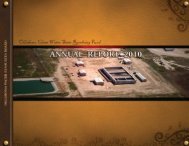Intended Use Plan for FY-2012 - Water Resources Board - State of ...
Intended Use Plan for FY-2012 - Water Resources Board - State of ...
Intended Use Plan for FY-2012 - Water Resources Board - State of ...
Create successful ePaper yourself
Turn your PDF publications into a flip-book with our unique Google optimized e-Paper software.
4.2-5b All building costs are eligible, not just stormwater, water efficiency andenergy efficiency related costs. Costs are not limited to the incrementaladditional costs associated with LEED certified buildings.4.2-5c U.S. Green Building Council websitehttp://www.usgbc.org/displaypage.aspx?CategoryID=194.2-6 Decentralized wastewater treatment solutions to existing deficient or failing onsitewastewater systems.4.2-6a Decentralized wastewater systems include individual onsite and/or clusterwastewater systems used to collect, treat and disperse relatively smallvolumes <strong>of</strong> wastewater. An individual onsite wastewater treatment systemis a system relying on natural processes and/or mechanical components,that is used to collect, treat and disperse or reclaim wastewater from asingle dwelling or building. A cluster system is a wastewater collection andtreatment system under some <strong>for</strong>m <strong>of</strong> common ownership that collectswastewater from two or more dwellings or buildings and conveys it to atreatment and dispersal system located on a suitable site near the dwellingsor buildings. Decentralized projects may include a combination <strong>of</strong> thesesystems. EPA recommends that decentralized systems be managed under acentral management entity with en<strong>for</strong>ceable program requirements, asstated in the EPA Voluntary Management Guidelines.http://www.epa.gov/owm/septic/pubs/septic_guidelines.pdf4.2-6b Treatment and Collection Options: A variety <strong>of</strong> treatment and collectionoptions are available when implementing decentralized wastewater systems. Theytypically include a septic tank, although many configurations include additionaltreatment components following or in place <strong>of</strong> the septic tank, which provide <strong>for</strong>advanced treatment solutions. Most disperse treated effluent to the soil where furthertreatment occurs, utilizing either conventional soil absorption fields or alternative soildispersal methods which provide advanced treatment. Those that discharge tostreams, lakes, tributaries, and other water bodies require federal or state dischargepermits (see below). Some systems promote water reuse/recycling, evaporation orwastewater uptake by plants. Some decentralized systems, particularly cluster orcommunity systems, <strong>of</strong>ten utilize alternative methods <strong>of</strong> collection with smalldiameter pipes which can flow via gravity, pump, or siphon, including pressuresewers, vacuum sewers and small diameter gravity sewers. Alternative collectionsystems generally utilize piping that is less than 8 inches in diameter, or the minimumdiameter allowed by the state if greater than 8 inches, with shallow burial and do notrequire manholes or lift stations. Septic tanks are typically installed at each buildingserved or another location upstream <strong>of</strong> the final treatment and dispersal site.Collection systems can transport raw sewage or septic tank effluent. Another populardispersal option used today is subsurface drip infiltration. Package plants thatdischarge to the soil are generally considered decentralized, depending on thesituation in which they are used. While not entirely inclusive, in<strong>for</strong>mation ontreatment and collection processes is described, in detail, in the “Onsite WastewaterTreatment Technology Fact Sheets” section <strong>of</strong> the EPA Onsite Manualhttp://www.epa.gov/owm/septic/pubs/septic_2002_osdm_all.pdf and on EPA‟s septicsystem website under Technology Fact Sheets.http://cfpub.epa.gov/owm/septic/septic.cfm?page_id=2834/21/2010 PART A - CWSRF 11





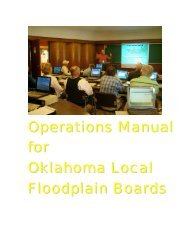
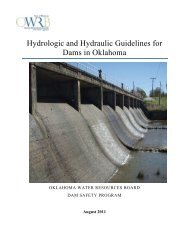


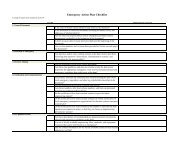



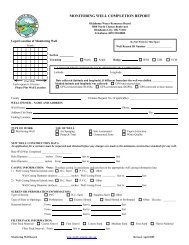
![A Commodity & a Resource [pdf] - Water Resources Board - State of ...](https://img.yumpu.com/42536671/1/190x143/a-commodity-a-resource-pdf-water-resources-board-state-of-.jpg?quality=85)

